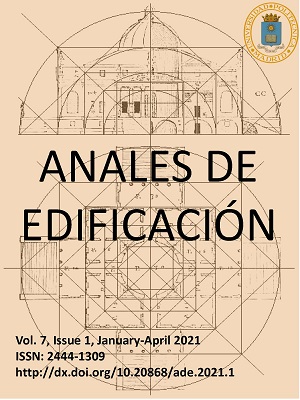Nuevas posibilidades de expresividad del hormigón: definición, componentes y clasificación de sistemas de encofrado flexible = New possibilities of concrete expressiveness: definition, components and classification of fabric formwork systems
DOI:
https://doi.org/10.20868/ade.2021.4771Palabras clave:
encofrados flexibles, sistemas de encofrados, hormigón, nuevas formas, membranas de encofrado, fabric formwork, formwork systems, concrete, new forms, membrane materialsResumen
Los sistemas de encofrado flexible generan nuevas posibilidades de expresión en elementos de hormigón. El presente artículo clasifica los sistemas de encofrado flexible y su principal componente la membrana contenedora, establece además una terminología en castellano y definición adecuadas a esta tecnología de encofrados. Este articulo sistematiza el uso de procedimientos de construcción de encofrados flexibles asociando sistemas y tipología de encofrados con la forma del objeto de hormigón a construir. Se establecen 8 tipologías de sistemas y 16 grupos de membranas. Se muestran los procesos y grupo de membranas empleadas en 19 de los sistemas de encofrado flexible más representativos. Los sistemas seleccionados permiten la construcción de todo tipo de elementos de hormigón, la flexibilidad de la membrana permite ampliar el abanico de formas y explotar al máximo las posibilidades creativas y de expresividad del hormigón
Abstract
Flexible formwork systems generate new expression possibilities in concrete elements. This article classifies flexible formwork systems and their main component the container membrane, also establishes a terminology in Spanish and definition appropriate to this formwork technology. This article systematizes the use of fabric formwork construction procedures by associating formwork systems and typology with the shape of the concrete object to be constructed. 8 types of systems and 16 groups of membranes are established. The processes and group of membranes used in 19 of the most representative flexible formwork systems are shown. The selected systems allow the construction of all kinds of concrete elements, the flexibility of the membrane allows to expand the range of shapes and make the most of the creative and expressive possibilities of concrete
Descargas
Referencias
Abdelgader, H., West, M.& Górski, J. (2008). State-of-the-Art Reporto n Fabric Formwork. Proceedings of the International Conference on Construction and Building Technology, Kuala Lumpur, Malasia.
Araya, R. & West, M. (2012). Flat sheet fabric moulds for double curvature precast concrete elements.. Ponencia del ICFF2012, Bath. BISFA. (2015) Asociación internacional de productores de fibras hechas por el hombre. www.bisfa.org Conlon, C. (2012). James Waller’s contribution to the advancement of shell roof construction and fabric formed concrete. Ponencia del ICFF2012, Bath Fisac Serna, M. (1972). Sistema de Encofrados Flexibles para Hormigon. No de publicación: ES0382096 A1, 16.10.1972 García Santos, A. (2005). Estructura y propiedades. Editor: Instituto Juan de Herrera. García Santos, A. (2005). Fabricación, durabilidad y tipos. Editor: Instituto Juan de Herrera.
Grünewald, S., Janssen, B., Schipper, H.R., Vollers, KJ., & Walraven, J.C. (2012) Deliberate deformation of concrete after casting. Ponencia del ICFF2012, Bath.
Hawkswood, M. (2012). Fabric Formwork Systems used in Marine Construction. Ponencia del ICFF2012, Bath.
Huijben, F., Van Herwijnen, F. R. A. N. S., & Nijsse, R. (2011). Concrete shell structures revisited: introducing a new ‘low-tech’construction method using vacuumatics formwork. In Structural Membranes 2011: V International Conference on Textile Composites and Inflatable Structures. 2011.
Lilienthal, G. (1899) Fire proof cealing. U.S. Patent 619,769
Navarro Segura, M.I. (2003). Miguel Fisac 2003 Basa, ISSN 0213-0653, Nº. 27, 2003, págs. 5-39
Martin, G Hawkswood M. (2012) Fabric Formwork Systems Used in Mariene Construction. ICFF 2012 (P45)
Pronk, A.D.C., (2006) The 2 milion euro Philipspavilion IASS Symposium Beijing p. 508
Pronk, A., Houtman, R. & Afink M. (2007). The Reconstruction of the Philips Pavilion. In: Hussain Mousa Dashti, ed., Ponencia de the conference Sources of architectural form, Kuwait, 15 pages.
Pronk, A., Bullens, T. & Folmer T. (2007). A Feasible Way to Make Freeform Shell Structures - IASS, Venetië, 8 pages,
Schmitz, R.P. (2014) Fabric-formed Concrete: A novel method for forming concrete structures. Civil Engineering and Urban Planning III. 183-189.
South, DB. & South. B. (1979). Building structure and method of making same. US Patent 4,155,967.
Tang, G. (2012). The Rise and Fall of The Thin Concrete Shell. Form Active structures and its relationship to Formwork: A cultural assessment of past application and future impact on architectural design. Ponencia del ICFF2012, Bath.
Vollers, K.J. & Rietbergen, D. (2009). A method and apparatus for forming a double‐curved panel from a flat panel; PCT; WO 2009/002158 A1; 31‐12‐2008.
Veenendaal, D., West, M. & Block, P. (2011). History and overview of fabric formwork: using fabrics for concrete casting. Ernst & Sohn Verlag für Architektur und technische Wissenschaften GmbH & Co. KG, Berlin · Structural Concrete 12, No. 3, 2011.
Descargas
Publicado
Número
Sección
Licencia
1. Los autores conservan los derechos de autor y garantizan a la revista el derecho de una Licencia Creative Commons Atribución - Nocomercial 4.0 Internacional que permite a otros compartir el trabajo con un reconocimiento de la autoría y uso no comercial.
2. Los autores pueden establecer por separado acuerdos adicionales para la distribución no exclusiva de la versión de la obra publicada en la revista (por ejemplo, situarlo en un repositorio institucional o publicarlo en un libro).
Salvo indicación contraria, todos los contenidos de la edición electrónica se distribuyen bajo una licencia de uso y distribución “Creative Commons"












